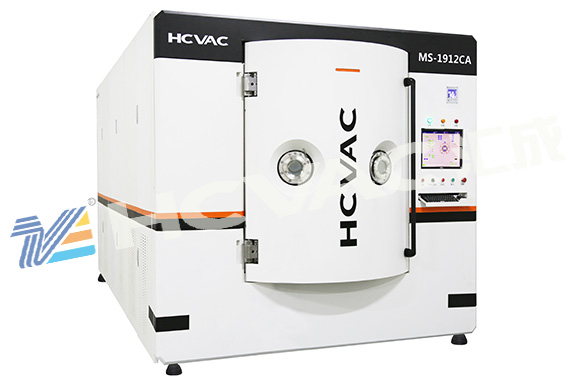With the continuous improvement of living standards, the usability of coating is becoming more and more extensive, and the requirements for coating technology are becoming higher and higher. Various types of pvd coating machine are also gradually emerging. But when it comes to the uniformity of thin films, the uniformity of thin films deposited by most vacuum equipment is affected by various factors. Now let's take a look at the factors that cause non-uniformity in sputtering coating machines.

The operation principle of pvd coating machine is actually very simple. It is achieved by bombarding the target material with argon ions formed by electrons bombarding the argon gas through an orthogonal magnetic field in a vacuum state, and the target ions are deposited on the surface of the workpiece to form a film. Therefore, manufacturers of car lamp coating machines should consider three aspects related to the uniformity of film thickness: vacuum state, magnetic field, and argon gas. The vacuum state needs to be controlled by the exhaust system, and each exhaust port must be activated simultaneously with consistent force to control the uniformity of the exhaust. If the exhaust is uneven, the pressure in the vacuum chamber cannot be uniform, and the pressure has a certain impact on the movement of ions. In addition, the pumping time should also be controlled. If it is too short, it will cause insufficient vacuum, but if it is too long, it will waste resources. However, with the existence of a vacuum machine, it is not a problem to control it well. Below, we will describe the conditions required to control the uniformity of the film layer.
1、 It is very important to clean the surface of substrate (substrate) for processing vacuum deposition process. Before entering the coating room, the substrate should undergo careful pre coating cleaning treatment to achieve the goal of degreasing, decontamination, and dehydration of the workpiece. The surface pollution of the substrate comes from various dust, lubricating oil, engine oil, polishing paste, grease, sweat stains and other substances adhered to the parts during processing, transmission, and packaging; The oxide film generated on the surface of the part in humid air; Gas absorbed and adsorbed on the surface of the part. The vacuum deposition manufacturers can basically remove these contaminants by degreasing or chemical cleaning. Clean surfaces that have undergone cleaning treatment should not be stored in an atmospheric environment, but should be stored in closed containers or cleaning cabinets to reduce dust contamination. Storing glass substrates in freshly oxidized aluminum containers can minimize the adsorption of hydrocarbon vapors. Because these containers prioritize the adsorption of hydrocarbons. For highly unstable and water vapor sensitive surfaces, they should generally be stored in a vacuum drying oven. Removing dust from the coating room, setting up a highly clean workspace, and maintaining a high level of cleanliness are the basic requirements for the environment in the coating process. In areas with high air humidity, in addition to carefully cleaning the substrate and various components in the vacuum chamber before plating, baking and degassing should also be carried out. To prevent oil from entering the vacuum chamber, pay attention to the return of oil from the oil diffusion pump. For diffusion pumps with high heating power, oil blocking measures must be taken.
2、 Basic Principles of Plating and Coating
A. Raw materials and basic principles:
The raw materials are all resins, polymers, ferrofluorones, silicones, acrylic acids, silicates, etc., and the auxiliary materials, formulas, and measurements vary. The emulsifier added can be mixed in different amounts, resulting in a different state of emulsification, which can be achieved in the form of water, emulsion, or paste. After emulsification and demulsification, these substances partially penetrate or form a thin film.
B. Their characteristics and differences:
Plating: Good penetration function (depending on the particle size of the raw material), better surface smoothness, suitable for European and American car series paint surfaces with more "fine pores", roughness, re sprayed paint, and hard paint surfaces that require increased brightness.
Coating: the coating products are added with film forming additives and curing agents, and the vacuum deposition manufacturers make them form films instantly, and the properties have changed accordingly. For example, the hardness is higher than that of the sealing glaze, which is more suitable for paint surfaces that need to improve the hardness (such as Japanese and Korean car series).
Special note: In terms of the function of filtering and reflecting ultraviolet rays, the Ge Nai coating is superior to the coating. Because it does not require the addition of film forming additives and curing agents, the more pure quartz glass molecule covering layer+fusion layer has stronger dual filtration and UV reflection ability. It is worth worrying that low-quality coating products using non environmentally friendly film forming additives may even cause secondary chemical damage to the paint surface.
The main performance of the protective layer:
① Preventing oxidation and fading of the original car paint: blocking ultraviolet rays and minimizing the transmission damage of ultraviolet rays.
② Increase the brightness of the paint surface: The crystal clear glass molecules make the car paint shine brightly and shine brightly.
③ Improve paint hardness: Improve wear and scratch resistance.
④ Prevent chemical sexual assault and extend the service life of paint: such as alkaline car wash, acid rain and salt spray, insect sap gum
The damage of high temperature and severe cold to car paint.
⑤ Increase the smoothness of the car watch: it feels silky and smooth, reducing static electricity, dust adhesion, and wind resistance coefficient, making daily maintenance more convenient.



